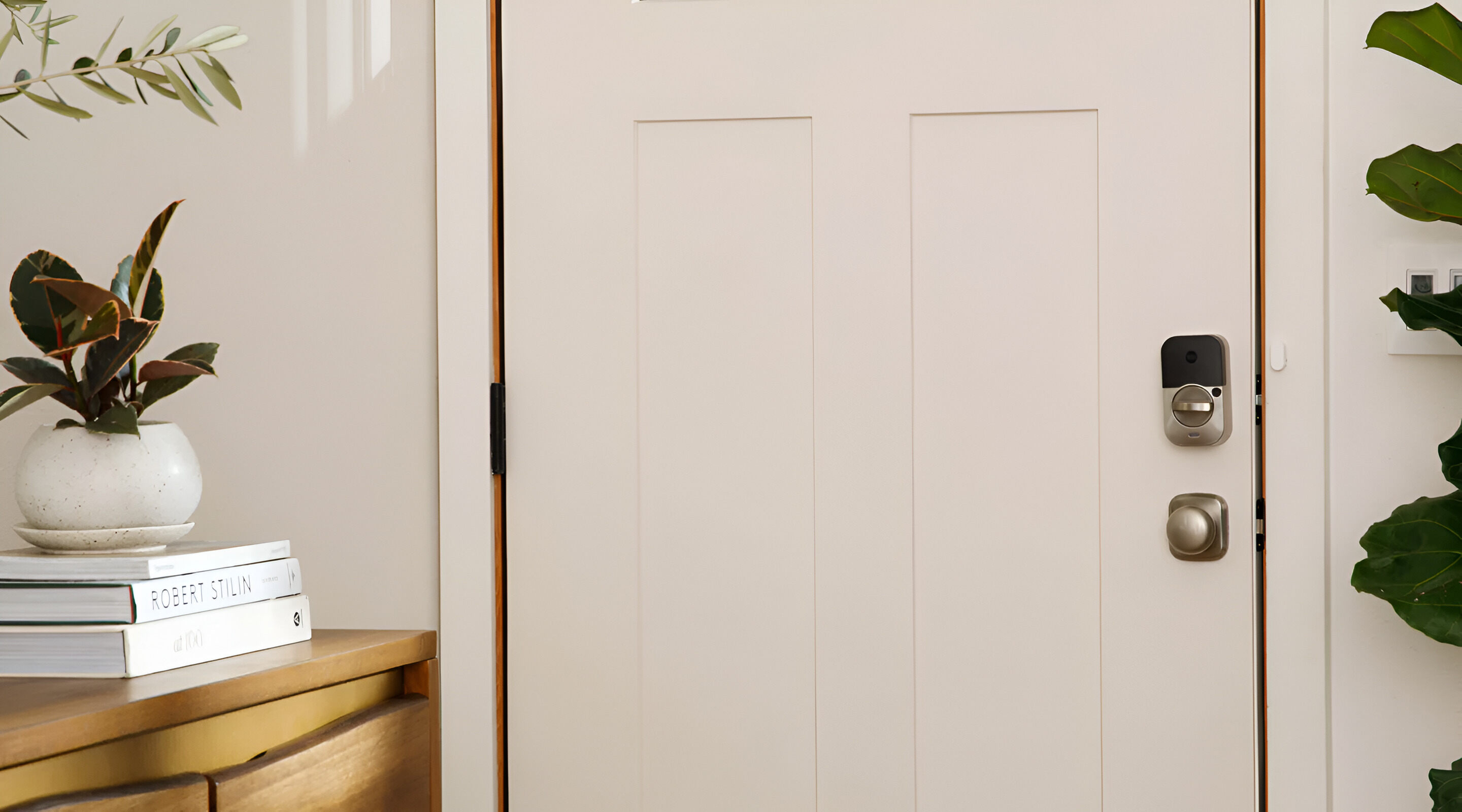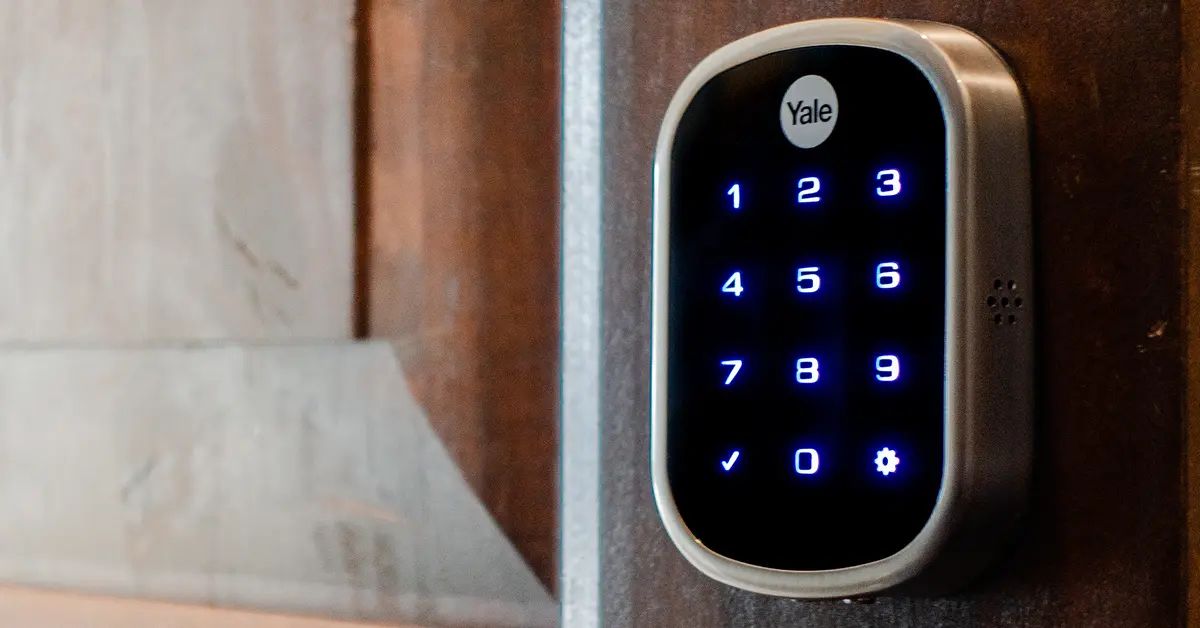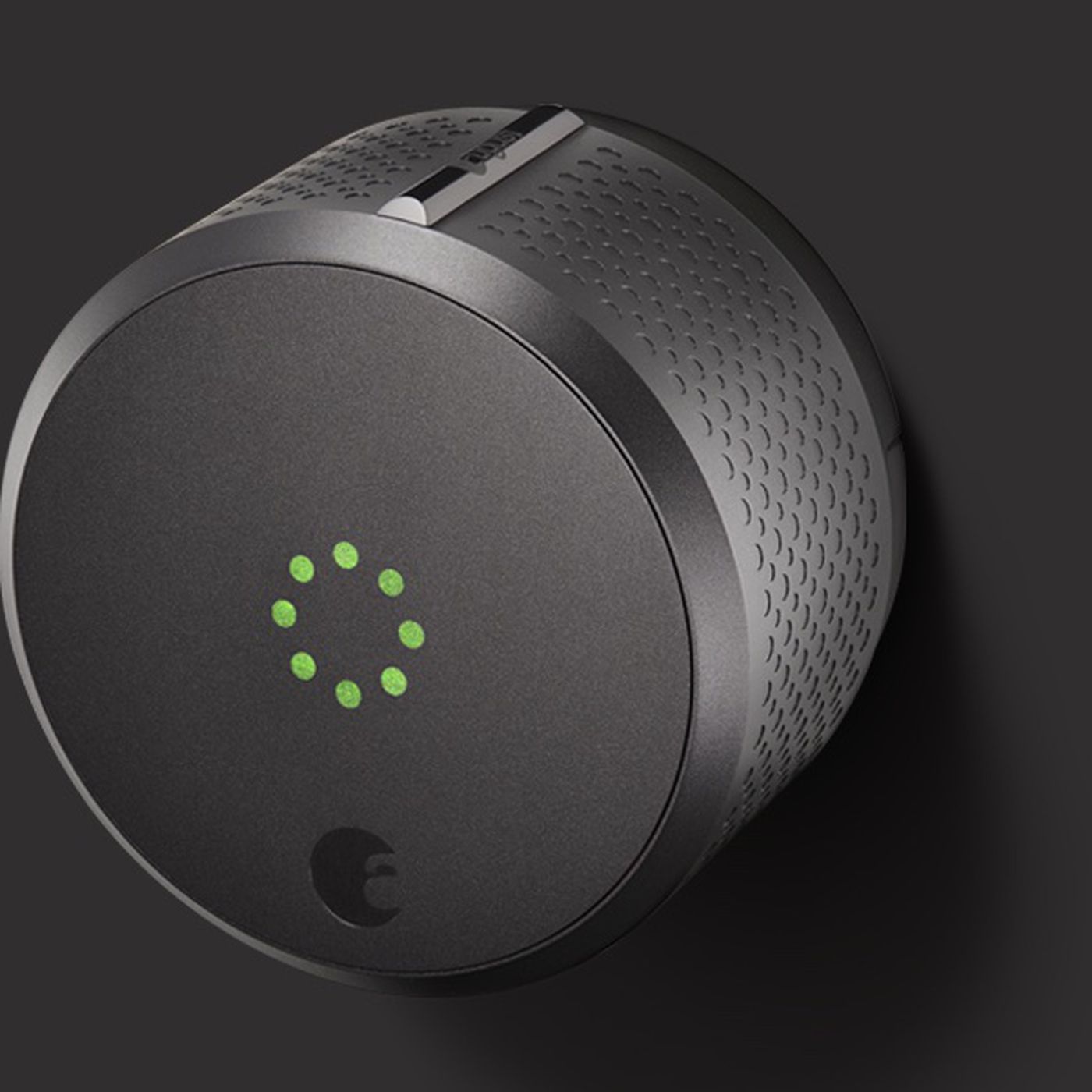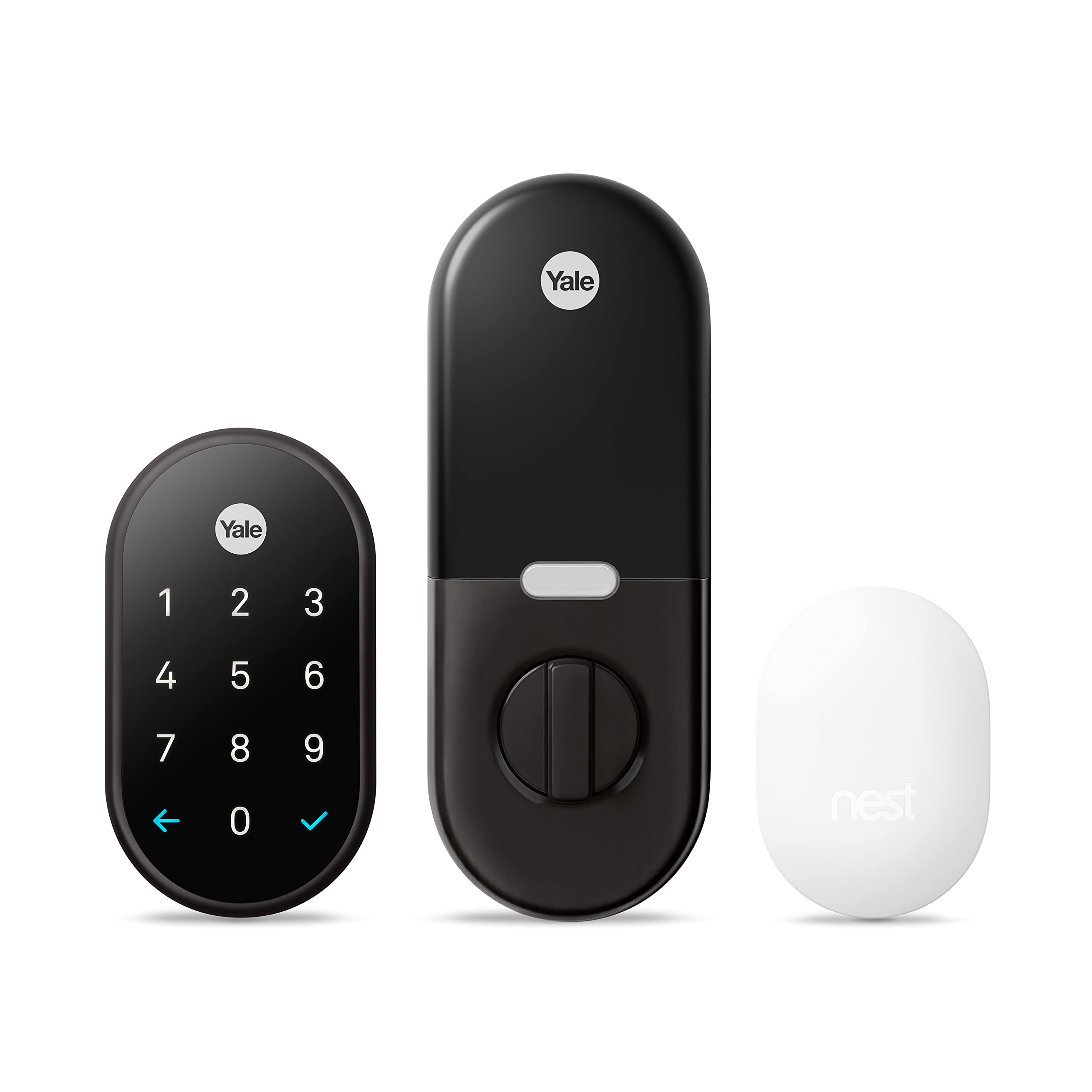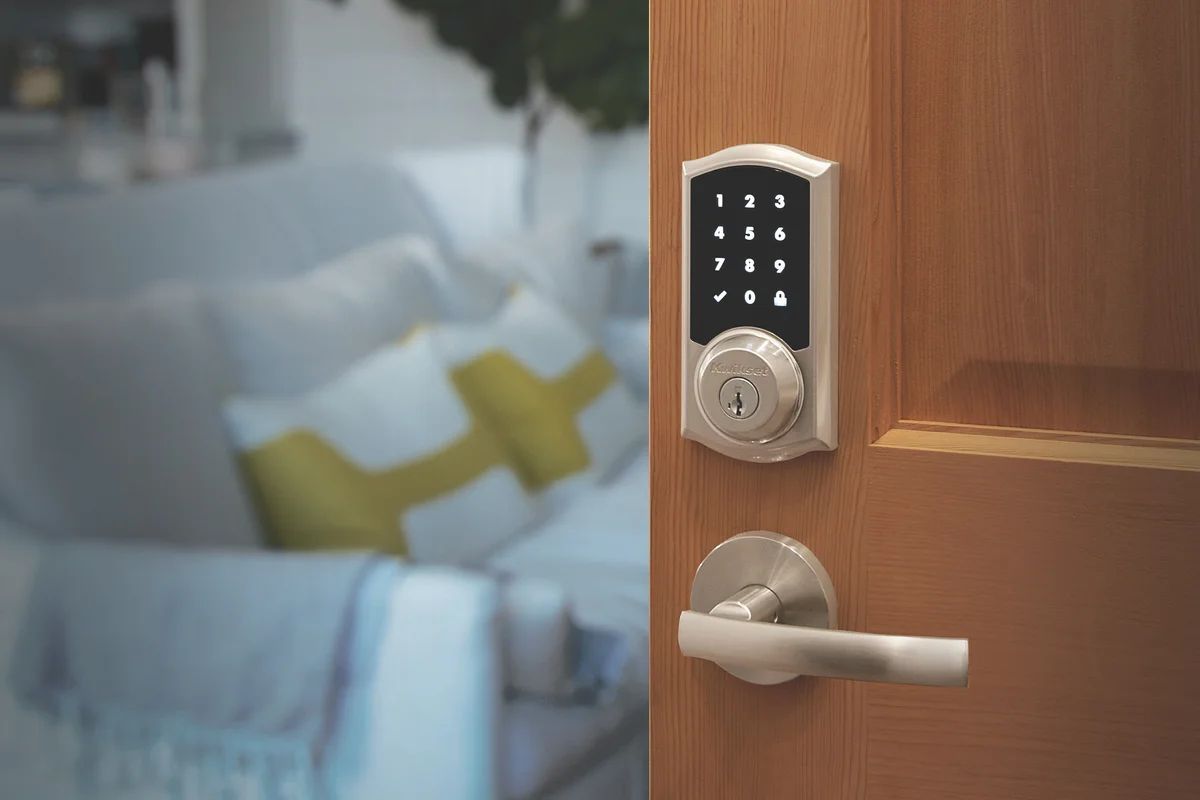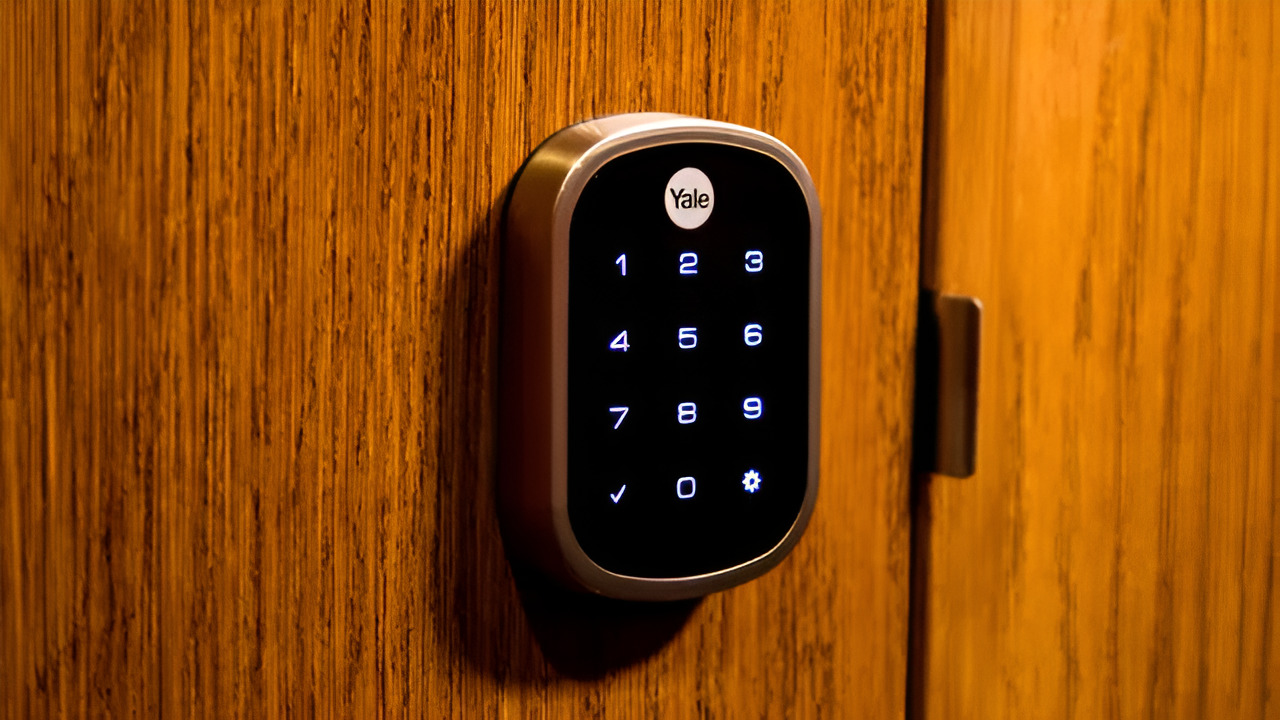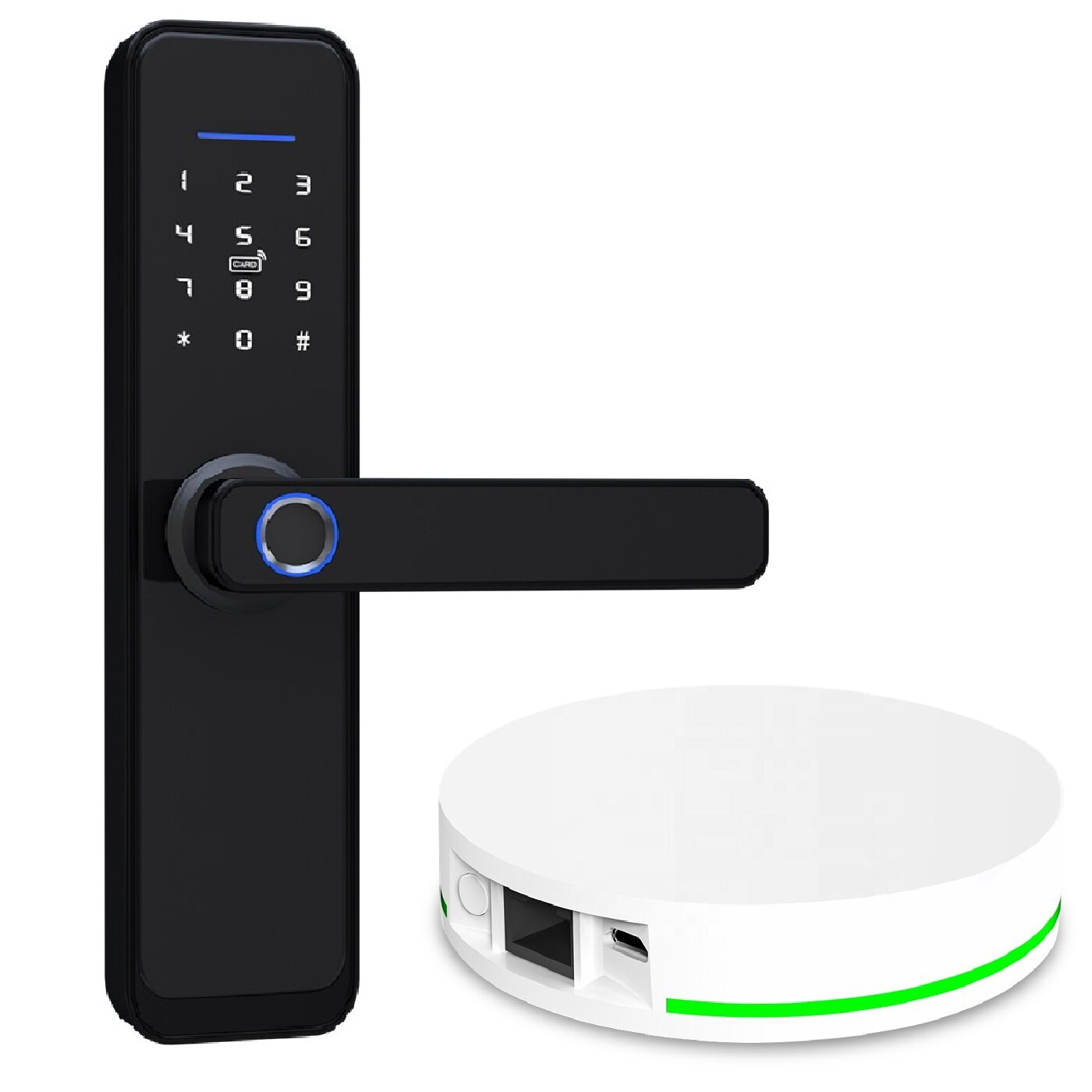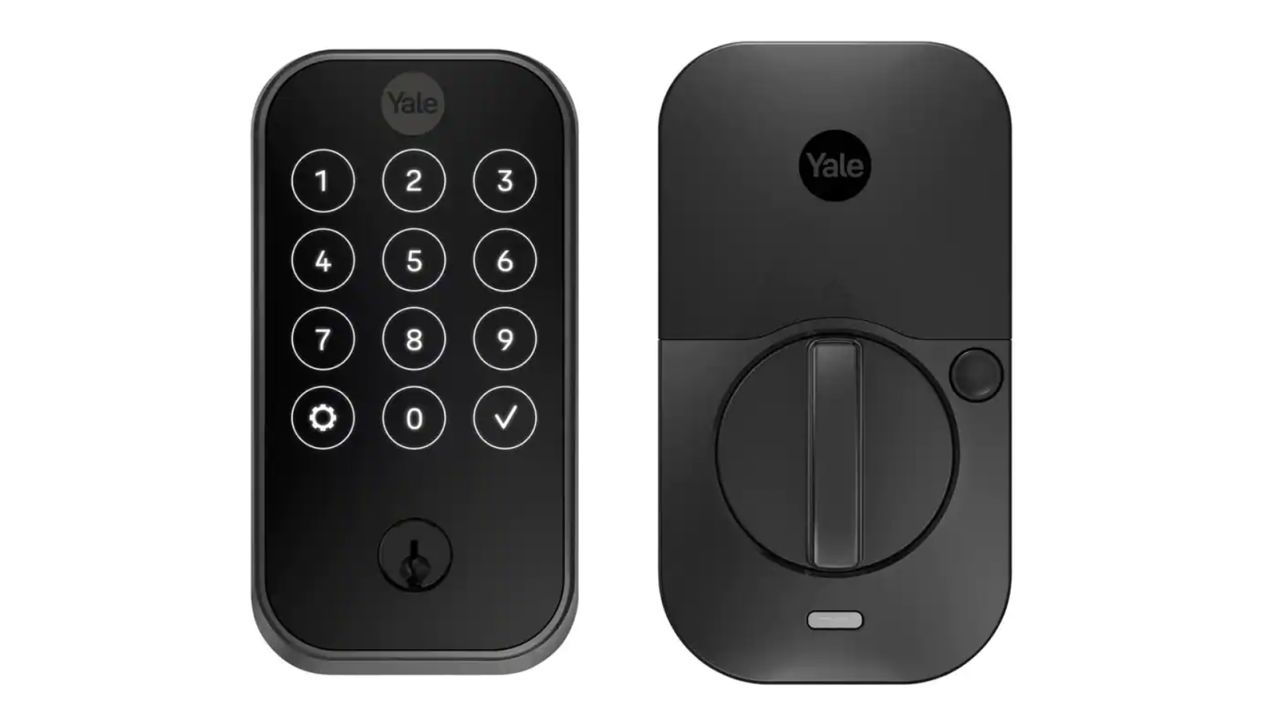Introduction
Imagine a world where you can effortlessly control the security of your home at your fingertips, even when you’re miles away. With a Z-Wave smart door lock, that fantasy can become a reality.
Z-Wave smart door locks are a cutting-edge technology that allows you to remotely manage and monitor your home’s entrance. These locks leverage the power of Z-Wave, a wireless communication protocol, to connect with your smart home hub and other compatible devices.
Whether you’re looking to enhance your home security, streamline access for family members and trusted visitors, or simply enjoy the convenience of keyless entry, a Z-Wave smart door lock is the ultimate solution. This intelligent device combines high-tech features with sleek and stylish design, making it a sophisticated addition to any modern home.
In this article, we’ll explore the ins and outs of Z-Wave smart door locks and discuss why they are a worthwhile investment. We’ll also provide a step-by-step guide on how to choose, install, and seamlessly integrate a Z-Wave smart door lock into your smart home ecosystem.
So, whether you’re a tech-savvy homeowner or just curious about the latest advancements in home security, read on to discover the incredible benefits and functionality of Z-Wave smart door locks.
What is a Z-Wave Smart Door Lock?
A Z-Wave smart door lock is a wireless device that integrates with your home automation system to provide convenient and secure access to your home. Unlike traditional locks that require physical keys, Z-Wave smart door locks utilize advanced technology to grant entry using digital credentials, such as passcodes or smartphone apps.
These locks communicate with your smart home hub using the Z-Wave communication protocol, which is designed specifically for home automation. Z-Wave technology operates on a low-power radio frequency, allowing for reliable and energy-efficient communication between devices.
One of the key advantages of Z-Wave smart door locks is their interoperability. They can seamlessly integrate with other Z-Wave compatible devices, such as security cameras, motion sensors, and lighting controls, creating a comprehensive smart home ecosystem.
Moreover, Z-Wave smart door locks offer a variety of features and functionalities that enhance the convenience and security of your home. Some common features include:
- Keyless Entry: Say goodbye to fumbling for keys. With a Z-Wave smart door lock, you can unlock your door using a personalized passcode, smartphone app, or even biometric authentication.
- Remote Access: Whether you’re at work, on vacation, or simply lounging on the couch, you can conveniently control and monitor your smart door lock from anywhere using your smartphone or computer.
- Guest Access: Grant temporary access to family members, friends, or service providers by creating unique passcodes or sharing virtual keys. You can easily revoke access when no longer needed.
- Activity Logs: Keep track of who enters and exits your home with detailed logs that record the date, time, and user associated with each lock action.
- Integration with Smart Home Ecosystem: Connect your Z-Wave smart door lock with other devices in your smart home setup to create custom automation scenarios and enhance overall security.
With these features, a Z-Wave smart door lock offers both convenience and peace of mind. You no longer have to worry about lost keys, spare keys, or unauthorized access to your home. Instead, you have full control over who enters your home and when, all from the palm of your hand.
Why Should You Use a Z-Wave Smart Door Lock?
Investing in a Z-Wave smart door lock offers numerous benefits that can greatly enhance the security, convenience, and efficiency of your home. Here are some compelling reasons why you should consider using a Z-Wave smart door lock:
Enhanced Security:
A Z-Wave smart door lock provides a higher level of security compared to traditional locks. With features like keyless entry and personalized passcodes, you eliminate the risk of losing keys or having them fall into the wrong hands. Additionally, Z-Wave smart door locks often come with built-in encryption, making it extremely difficult for hackers to breach your home security system.
Convenience and Flexibility:
Gone are the days of fumbling for your keys in the dark or having to return home to let someone in. With a Z-Wave smart door lock, you can unlock your door with a simple touch or by entering a unique code. You can also monitor and control your lock remotely, granting access to trusted visitors or service providers from anywhere with an internet connection.
Integration with Smart Home Ecosystem:
A Z-Wave smart door lock seamlessly integrates with your existing smart home ecosystem. This allows you to create personalized automation scenarios, such as automatically unlocking the door when you arrive home or triggering the security system when the door is locked. By integrating your lock with other devices, you can enhance the overall security and efficiency of your home.
Increased Awareness and Control:
Z-Wave smart door locks provide detailed activity logs, allowing you to track who enters and exits your home and at what time. This feature can be particularly useful for monitoring the comings and goings of family members, service providers, or house guests. You can also receive real-time notifications on your smartphone whenever the door is locked or unlocked, giving you peace of mind and ensuring you stay in control.
Energy Efficiency:
Z-Wave smart door locks utilize low-power wireless communication, making them energy-efficient. They consume minimal power and can operate on a single set of batteries for a long duration, saving you money on replacements. Some smart locks even have battery level indicators, allowing you to proactively replace the batteries before they run out.
With these benefits, it’s clear why Z-Wave smart door locks are becoming increasingly popular. They offer a convenient, secure, and flexible solution for controlling access to your home, providing you with peace of mind and making your daily life more efficient.
How to Choose the Right Z-Wave Smart Door Lock for Your Home
When selecting a Z-Wave smart door lock for your home, it’s important to consider several factors to ensure you choose the right one that fits your specific needs. Here are some key considerations to keep in mind:
Compatibility:
Check the compatibility of the Z-Wave smart door lock with your existing smart home hub or system. Ensure that they are compatible and can communicate seamlessly. Some Z-Wave locks might work with specific systems or require additional components for integration, so verify compatibility before making a purchase.
Design and Aesthetics:
Choose a Z-Wave smart door lock that complements the overall aesthetic of your home. Look for a design that aligns with your preferences and matches the style of your front door. Z-Wave smart door locks come in various finishes and styles, allowing you to find one that blends seamlessly with your home’s existing decor.
Security Features:
Consider the security features offered by the Z-Wave smart door lock. Look for features like built-in encryption, tamper alarms, and auto-locking capabilities. Additionally, check if the lock has undergone industry-standard security certifications to ensure its reliability and protection against unauthorized access.
Access Methods:
Determine the different access methods supported by the Z-Wave smart door lock. Common options include keypad entry, smartphone app access, and key fobs. Choose a lock that offers multiple access methods to cater to different preferences and user needs.
Battery Life:
Check the estimated battery life of the Z-Wave smart door lock. Look for locks that have long battery life and provide battery level indicators to ensure you’re aware of when to replace them. It’s important to choose a lock that won’t require frequent battery changes.
User Management:
Consider the user management capabilities of the Z-Wave smart door lock. Look for locks that allow you to create and manage multiple user codes or virtual keys. This feature is particularly useful for granting temporary access to guests or service providers and revoking access when necessary.
Reviews and Recommendations:
Read customer reviews and recommendations for the Z-Wave smart door lock you’re considering. This will give you insights into its performance, reliability, and user experience. Consider feedback from other users to help you make an informed decision.
By taking these factors into account, you can select the right Z-Wave smart door lock that meets your security requirements, seamlessly integrates with your smart home system, and suits your personal preferences.
Step 1: Installing the Z-Wave Smart Door Lock
Installing a Z-Wave smart door lock requires a few simple steps to ensure proper functionality and security. Follow this step-by-step guide to install your Z-Wave smart door lock:
1. Gather the Necessary Tools:
Before you begin, gather the tools needed for installation. These typically include a screwdriver, measuring tape, and possibly a drill if you need to make any additional holes for the lock.
2. Prepare the Door:
Inspect the door to ensure it is in good condition and the existing deadbolt is functioning properly. Remove any dirt or debris from the area where the new lock will be installed. If necessary, use the provided template to mark the correct placement of the new lock.
3. Remove the Existing Deadbolt:
Using a screwdriver, remove the screws securing the existing deadbolt. Take note of the orientation of the components as you will need to reinstall the new lock in the same configuration.
4. Install the New Z-Wave Smart Door Lock:
Follow the manufacturer’s instructions to install the new Z-Wave smart door lock. This typically involves inserting the latch into the door and securing it with screws. Attach the exterior and interior parts of the lock, aligning them correctly, and secure them tightly.
5. Install Batteries:
If your Z-Wave smart door lock is battery-powered, install the provided batteries according to the manufacturer’s instructions. Ensure the batteries are inserted correctly, and the battery terminals make proper contact.
6. Test the Lock:
Before completing the installation, test the Z-Wave smart door lock to ensure it functions properly. Test the lock by locking and unlocking it from the inside and outside using the designated methods.
7. Adjust the Strike Plate:
If necessary, adjust the strike plate on the door jamb to ensure it aligns properly with the latch. This can be done by loosening the screws and moving the strike plate slightly until the latch engages smoothly.
8. Secure the Lock:
Once you’re satisfied with the installation and the lock is functioning correctly, tighten all the screws and secure the lock in place. Verify that there is no excess movement or looseness.
Following these step-by-step instructions will help you install your Z-Wave smart door lock correctly and securely. Remember to consult the manufacturer’s specific installation guide for any additional steps or precautions.
Step 2: Pairing the Z-Wave Smart Door Lock with Your Smart Home Hub
Once you have successfully installed your Z-Wave smart door lock, the next step is to pair it with your smart home hub or controller. By connecting the lock to your smart home ecosystem, you can unlock a world of automation and remote control capabilities. Follow these steps to pair your Z-Wave smart door lock with your smart home hub:
1. Prepare Your Smart Home Hub:
Ensure that your smart home hub or controller is powered on and ready for pairing. Refer to the manufacturer’s instructions to familiarize yourself with the specific pairing process for your hub.
2. Initiate Pairing Mode on the Lock:
Enter the necessary pairing or inclusion mode on your Z-Wave smart door lock. This procedure might differ among manufacturers, so consult your lock’s user manual or follow the instructions provided by the manufacturer.
3. Start the Pairing Process on the Smart Home Hub:
Depending on your smart home hub, navigate to the pairing or inclusion section of your hub’s settings or app. Follow the instructions provided by the hub to initiate the pairing process for Z-Wave devices. This usually involves putting the hub into pairing mode and searching for nearby devices.
4. Pair the Lock and the Hub:
Once your smart home hub is in pairing mode, bring the Z-Wave smart door lock near the hub. The hub should detect the lock and display it as a new device available for pairing. Follow the on-screen instructions to complete the pairing process, typically by confirming a PIN or authentication code on the lock.
5. Test the Lock:
After successfully pairing the lock with your smart home hub, perform a test to ensure the connectivity is successful. Use the hub’s app or interface to remotely lock and unlock the smart door lock. The lock should respond accordingly, giving you visual and audible feedback to confirm its actions.
6. Naming and Customization:
Once the lock is paired, you may have the option to customize its settings. This includes giving the lock a name or assigning it to a specific room or area in your smart home app or interface. Take advantage of these customization options to easily identify and control your Z-Wave smart door lock within your home automation system.
By following these steps, you can pair your Z-Wave smart door lock with your smart home hub, enabling seamless integration and control from your smartphone, voice assistant, or other smart devices. Pairing your lock opens up a world of possibilities for automation, remote access, and enhanced security within your smart home ecosystem.
Step 3: Setting Up User Codes for Access
After successfully installing and pairing your Z-Wave smart door lock, the next step is to set up user codes for access. User codes are personalized passcodes that allow individuals to unlock the door without the need for physical keys. Follow these steps to set up user codes for your Z-Wave smart door lock:
1. Access the Lock’s Configuration:
Using your smart home hub’s app or interface, access the configuration settings for your Z-Wave smart door lock. Look for the section related to user codes and access management.
2. Add a New User:
Within the user code settings, locate the option to add a new user. This usually involves specifying a name or identifier for the user.
3. Assign a Unique Code:
Assign a unique code to the newly added user. This can be a numerical code or even a combination of letters and numbers, depending on the capabilities of your Z-Wave smart door lock.
4. Specify Access Permissions:
Determine the access permissions for the user code. You can set whether the code allows unrestricted access, temporary access only, or limited access during specific time intervals. Some locks even allow you to assign different access levels to different users.
5. Save the User Code:
Save the user code within the lock’s configuration or your smart home hub’s settings. Ensure that the code is securely stored and cannot be accessed by unauthorized individuals.
6. Communicate User Codes:
Inform the relevant individuals about their assigned user codes. Provide clear instructions on how to use the code to unlock the door, including any additional steps or specific instructions required by your Z-Wave smart door lock.
7. Test the User Codes:
Once the user codes are set up, test them to ensure they grant access as intended. Lock the door and attempt to unlock it using each user code. Verify that the door unlocks and relocks correctly with the assigned codes.
8. Manage and Update User Codes:
Regularly review and update the user codes for your Z-Wave smart door lock. Remove any codes that are no longer needed or assigned to individuals who no longer require access. This helps maintain proper access control and security.
By following these steps, you can easily set up user codes for your Z-Wave smart door lock, providing convenient and secure access for individuals without the need for physical keys.
Step 4: Integrating the Z-Wave Smart Door Lock with Other Devices
One of the key advantages of a Z-Wave smart door lock is its ability to seamlessly integrate with other devices in your smart home ecosystem. By integrating your lock with other devices, you can create custom automation scenarios and enhance the overall security and convenience of your home. Follow these steps to integrate your Z-Wave smart door lock with other devices:
1. Identify Compatible Devices:
Determine which devices in your smart home ecosystem are compatible with Z-Wave technology. These might include security cameras, motion sensors, smart lights, or a central smart home hub. Check the manufacturer’s specifications or consult your smart home system’s documentation to identify compatible devices.
2. Ensure Connectivity:
Ensure that all the devices are properly connected to your smart home hub or controller. Verify that they are working correctly and can communicate with the hub.
3. Access Automation Settings:
Access the automation or scene settings in your smart home hub’s app or interface. Look for the option to create or edit automation routines or scenes.
4. Create Automation Scenarios:
Set up automation scenarios that involve your Z-Wave smart door lock. For example, you can create a routine that automatically locks the door when all motion sensors detect no activity. Alternatively, you can configure the lock to unlock when a specific user’s smartphone is within range.
5. Customize Actions:
Customize the actions associated with the automation scenario. Determine what action the Z-Wave smart door lock should perform when triggered by other devices. For example, you can specify whether the door should lock or unlock, and under what conditions.
6. Test and Refine:
Test the integration and ensure that the automation scenario functions as intended. Make any necessary adjustments to fine-tune the actions and trigger conditions until you achieve the desired outcome.
7. Explore Additional Integration Options:
Consider exploring additional integration options with other devices in your smart home ecosystem. For example, you can connect your Z-Wave smart door lock with your voice assistant, allowing you to lock or unlock the door using voice commands.
8. Regularly Review and Update:
Regularly review and update your automation settings as your needs change. Remove or modify any automation scenarios that are no longer needed or require adjustments. Stay up to date with firmware updates for your Z-Wave smart door lock and other devices to ensure optimal compatibility and performance.
By following these steps, you can seamlessly integrate your Z-Wave smart door lock with other devices in your smart home, enhancing security, convenience, and automation capabilities.
Step 5: Troubleshooting Common Issues with Z-Wave Smart Door Locks
While Z-Wave smart door locks offer numerous benefits, there may be times when you encounter common issues or face challenges with their operation. Here are some troubleshooting steps to help you resolve common issues with Z-Wave smart door locks:
1. Check Power Source:
Ensure that your Z-Wave smart door lock has a reliable power source. If your lock is battery-powered, check the battery level and replace them if necessary. If your lock is connected to a power source, make sure the power supply is stable, and the lock is receiving power.
2. Verify Connectivity:
Check the connectivity status of your Z-Wave smart door lock. Ensure that it is properly paired with your smart home hub or controller. If the lock is having trouble connecting, try resetting the lock and re-pairing it with your hub.
3. Improve Signal Strength:
If you’re experiencing connectivity issues, particularly if your lock is located far from your smart home hub, consider improving the Z-Wave signal strength. You can do this by adding Z-Wave repeaters or range extenders throughout your home to amplify the signal and ensure reliable communication between devices.
4. Reset the Lock:
If your Z-Wave smart door lock is not functioning as expected, try resetting it to its factory default settings. Consult the manufacturer’s instructions to learn how to initiate a reset on your specific lock. Be aware that resetting the lock will remove all user codes and configuration settings, so be prepared to reconfigure the lock after the reset.
5. Update Firmware and Software:
Regularly check for firmware updates for your Z-Wave smart door lock. Firmware updates can often resolve any known issues or bugs and improve the overall performance of the lock. Additionally, check for updates to your smart home hub or controller software to ensure compatibility and optimal operation.
6. Consult the Manual and Support:
If you’re experiencing persistent issues with your Z-Wave smart door lock, consult the manufacturer’s manual or user guide. These resources often provide troubleshooting tips and guidance for specific issues you may encounter. If needed, reach out to the lock manufacturer’s support team for further assistance.
7. Perform a Physical Inspection:
Inspect the physical components of your Z-Wave smart door lock for any visible issues or obstructions. Ensure that the lock mechanism is properly aligned and free from debris. Check for loose screws or connections and tighten them if necessary.
8. Replace or Repair:
If all troubleshooting steps fail to resolve the issue and your Z-Wave smart door lock is still malfunctioning, consider contacting the manufacturer for repair or replacement options. Most locks come with a warranty that covers defects or hardware failures.
By following these troubleshooting steps, you can address common issues and ensure the optimal performance of your Z-Wave smart door lock, keeping your home secure and your smart home system running smoothly.
Conclusion
Z-Wave smart door locks offer a revolutionary way to enhance the security, convenience, and control of your home. Through their integration with your smart home hub and other compatible devices, these locks provide seamless automation, remote access, and personalized user management capabilities.
In this article, we explored the key features and benefits of Z-Wave smart door locks. We learned that these locks offer keyless entry, remote access, and detailed activity logs. They can integrate with other devices in your smart home ecosystem, providing enhanced security and customization options.
We also provided a step-by-step guide on how to choose, install, and integrate a Z-Wave smart door lock. From selecting the right lock for your home to troubleshooting common issues, we covered everything you need to know to successfully incorporate a Z-Wave smart door lock into your smart home setup.
By harnessing the power of Z-Wave technology, you can transform your house into a smart home that provides a higher level of security and convenience. With the ability to remotely control and monitor your door access, you no longer have to worry about lost or stolen keys. You can grant temporary access to trusted individuals and receive real-time notifications about who enters and exits your home.
While Z-Wave smart door locks offer incredible benefits, it’s important to remember that proper installation, pairing, and user code management are fundamental to maximizing their potential. Regularly updating firmware and troubleshooting any issues that arise will ensure smooth and reliable operation.
So embrace the future of home security and convenience by incorporating a Z-Wave smart door lock into your smart home ecosystem. Discover the joy of keyless entry, remote access, and personalized control with the power of Z-Wave technology.







